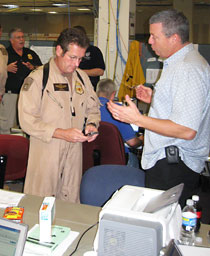Customs and Border Protection lends aerial vehicle for hurricane damage assessment
In its first-time use for a natural disaster, Predator sends real-time videos to agencies of storm's destruction.

Pete McNall, left, director of unmanned aircraft systems for Customs and Border Protection's southwest region, coordinates Predator unmanned flights in wake of Hurricane Gustav at the FEMA Joint Field Office in Baton Rouge, La. (Photo: Bob Brewin / NextGov)
Play video of Predator in action.
BATON ROUGE, LA - Predator unmanned aircraft usually fly over Afghanistan and Iraq on military missions or over the border with Mexico looking for illegal immigrants, but this week the Customs and Border Protection bureau used the drones to collect video of damage caused by Hurricane Gustav.
CBP typically uses the 27-foot long, propeller-powered aircraft to monitor illegal border entries, but for the first time the bureau used the Predator in response to a natural disaster, said Pete McNall, director of unmanned aircraft systems for the Southwest Region of CBP.
Comment on this article in The Forum. The bureau provided real-time streaming aerial video of damaged levees, roads, bridges and oil terminals over a secure Internet feed to 1,200 personnel from multiple federal agencies who worked here at the Federal Emergency Management Agency's joint field office. Federal officials in Washington, as well as state and local officials throughout Louisiana, could access the feed.
Pilots at a CBP base at Libby Army Airfield in Sierra Vista, Ariz., controlled the Predator. They interfaced with the Federal Aviation Administration's Houston air traffic control center just like pilots of commercial aircraft do. The Predator carries a transponder that identifies it to controllers at the center, which has responsibility for airspace over Louisiana and can respond to directions from controllers via a satellite voice link.
Defense Department Predators can fly only in military restricted airspace, McNall said, while CBP has an agreement with FAA for controlled airspace. The CBP Predator, which is operating out of the Corpus Christi Naval Air Station in the wake of Gustav, flies at an altitude of about 19,000 feet in a box pattern in FAA-controlled airspace, with the pilots on the ground in Arizona controlling the aircraft over a KU-band satellite link. The Predator can remain aloft for about 30 hours before it needs to land for refueling.
This link also transmits the imagery back to Sierra Vista, where it is fed into a video server for wide distribution.
CBP also is using the Predator to aid relief efforts for the impending landfall of Hurricane Hanna. On Thursday, CPB launched the Corpus Christi-based aircraft on a 12-hour mission to Savannah, Ga., to assess critical infrastructure ahead of the hurricane's possible weekend landfall there. The bureau plans to fly the Predator after the storm hits on the same track so FEMA and other agencies can make before and after comparisons.
NEXT STORY: Shortliffe will succeed Detmer at AMIA



